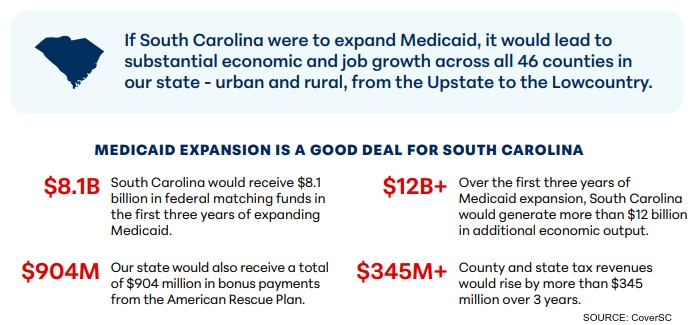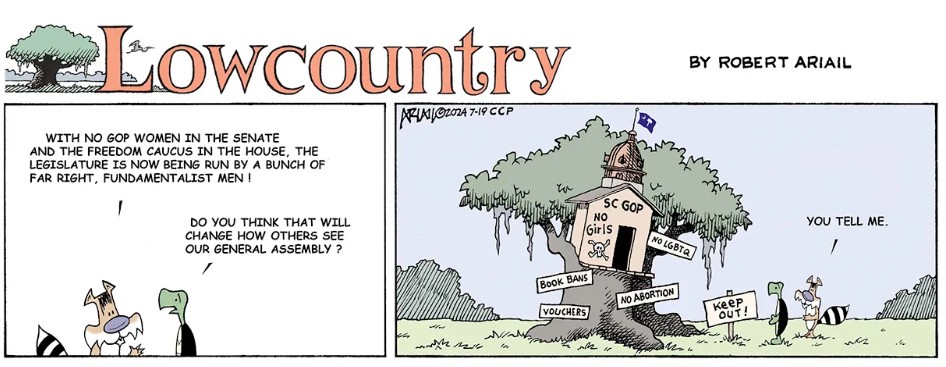STATEHOUSE REPORT | ISSUE 23.29 | July 19, 2024
BIG STORY: Project 2025: What it is; why it matters
MORE NEWS: Medicaid expansion would bring in billions
LOWCOUNTRY, Ariail: No girls allowed
COMMENTARY, Brack: What’s it going to take?
SPOTLIGHT: SC Clips
MYSTERY PHOTO: Portrait
FEEDBACK: Good piece on Medicaid expansion
Project 2025: What it is and why it matters

A news analysis by Jack O’Toole | To understand the debate surrounding Project 2025 – a controversial conservative federal governing blueprint prepared by the Heritage Foundation and its ideological allies, such as South Carolina’s Palmetto Promise Institute – it helps to remember there are two great political contests in America every four years.
 In the first, the Democratic and Republican parties duke it out to elect a president on the first Tuesday after the first Monday in November. Then, in the second, various factions in the winning party – say, conservative Christians and libertarian free-marketeers in the GOP, or Bernie Sanders-style social democrats and Clintonian moderates on the Democratic side – fight a sharp-elbowed inside game to win control of the newly-elected president’s policy agenda and staffing process before he’s sworn in on January 20.
In the first, the Democratic and Republican parties duke it out to elect a president on the first Tuesday after the first Monday in November. Then, in the second, various factions in the winning party – say, conservative Christians and libertarian free-marketeers in the GOP, or Bernie Sanders-style social democrats and Clintonian moderates on the Democratic side – fight a sharp-elbowed inside game to win control of the newly-elected president’s policy agenda and staffing process before he’s sworn in on January 20.
For Beltway think tanks like the Heritage Foundation, once run by former GOP U.S. Sen. Jim DeMint of South Carolina, the first contest is the playoffs. The second is the Super Bowl. And Project 2025, with its detailed, 992-page policy plan and database of pre-vetted potential staffers, is the foundation’s bid to win the big game if Trump wins a second term.
Why Project 2025 matters
So why all the hair-on-fire hullabaloo, if Project 2025 is basically just one conservative group’s long-ball effort to influence a future Trump administration? Experts say there are three good reasons to take it seriously.
First, Trump is a politician with strong instincts – immigration bad, defense good – but few concrete proposals. That kind of policy vacuum creates an ideal political environment at an untethered White House for enterprising ideologues, such as the wonks of the Heritage Foundation.
Second, Heritage has played and won this game before, most famously in 1980, when its pre-election governing plan was largely adopted by the incoming Reagan administration. By December 1982, more than 60% of the plan’s 2,000 recommendations had been implemented.
And third, the policy agenda outlined in Project 2025 is, as 2012 Republican presidential nominee and current U.S. Sen. Mitt Romney would say, severely conservative. In fact, some of its hard-right proposals have proven so divisive that even Trump very publicly distanced himself recently from the plan, calling it “absolutely ridiculous and abysmal” in a July 5 social media post.
So with that history and context in mind, let’s take a look at what’s in the plan – and just as important, what isn’t.
Expanding presidential power
 In keeping with the currently fashionable view among some conservatives that all executive power is vested in the person of the president – the so-called “unitary executive theory” – Project 2025 recommends several changes that would expand the president’s power across the federal government.
In keeping with the currently fashionable view among some conservatives that all executive power is vested in the person of the president – the so-called “unitary executive theory” – Project 2025 recommends several changes that would expand the president’s power across the federal government.
A return to the “spoils system:” Since the passage of the Pendleton Act in 1883, all but the very top jobs in the federal government have been held by professional civil servants hired under a merit-based system. Project 2025 would reclassify tens of thousands of those jobs from civil service positions to political appointments, all serving at the pleasure of the president. While this would clearly make it easier for a president to implement his policies across the federal government, critics note that it could also signal a return to the cronyism and corruption of an earlier era in American history.
Political dispersal of federal funds: If political appointees move into jobs previously held by professionals, the apportionment of billions of dollars in federal program funds would for the first time be directly controlled by political supporters of the president. This could affect spending in virtually every area of government, including transportation projects, storm recovery efforts, vendor contracts and more.
Politicizing justice: With a more political staff and a clear mandate to bring the entire executive branch under direct presidential control, the bipartisan post-Watergate tradition of Justice Department independence could effectively come to an end, according to a PBS report.
Playing the hits
The bulk of Project 2025 is a conservative wish list that will be familiar to anyone who’s been following American politics since the 1980s. Here are some of the highlights.
Tax cuts: Under the plan, the top income tax rate would be cut from 37% to 30%, and corporate taxes would fall from 21% to 18%. All individual incomes under $170,000 would be taxed at 15%, representing a tax cut for most middle earners but a tax increase for those at the bottom.
Deregulation: The plan also calls for dramatic deregulation of the economy and environment, including an end to all federal preferences for green energy over fossil fuels.
Cutting programs for the poor: Currently, federal Medicaid funds flow to states based on need – in other words, how many people qualify and what medical services they’re receiving. Under Project 2025, these funds would be converted into block grants with strict work requirements, forcing states to cut Medicaid expenditures or raise state taxes to pay for them. The plan also calls for cuts in other federal anti-poverty programs, including Temporary Assistance for Needy Families (what most people mean when they say “welfare”), cuts to nutritional assistance and the elimination of Head Start.
Dismantle the Department of Education: If adopted in full, Project 2025 would eliminate the U.S. Department of Education, privatize student loans and replace most federal education programs with block grants to the states. It also endorses a dramatic expansion of school choice, including the use of public funds for tuition at private religious schools.
Waging the culture war
In calling for a return to the “biblically based, social science-reinforced definition of marriage and family” (page 481), an end to all forms of “woke propaganda” (page 9) and the jailing of pornographers (page 5), Project 2025 is clear in its intention to make the federal government a combatant in the culture war.
Abortion: Under the plan, the Food and Drug Administration would reverse its approval of the abortion pill, Mifepristone (page 458) , and the Comstock Act would be revived to make any mailing of the product illegal (page 459). It would also end the federal requirement that health insurance policies cover “Plan B” emergency contraception. (page 485)
Immigration: Though Project 2025 does not explicitly call for a round-up of illegal immigrants and the establishment of detention camps as some have reported, Project 2025 would create a 100,000-person strong cabinet level agency focused on border and immigration enforcement. The plan would also end student-loans at universities that allow illegal immigrants to pay in-state tuition, and ban non-citizens from federally-subsidized housing.
DEI: Under the plan, diversity, equity and inclusion initiatives would be strictly curtailed within the federal government, and federal funds and authority would be used to limit affirmative action in the public and private sectors (page 582). In addition, it would reinstate the Trump-administration ban on transgender men and women serving in the military. (page 104)
What’s not in Project 2025
Several false claims about Project 2025 have gone viral in social media since the plan became an issue in the presidential election. So to wrap things up, here’s a list of the Top 10 items that aren’t in the plan, according to an examination of the text and reliable sources on the left and right:
- An end to no-fault divorce
- A ban on all contraceptives
- A nationwide abortion ban
- Cuts to Social Security and Medicare
- Repeal of Obamacare
- Ending marriage equality
- Ending birthright citizenship and Muslim immigration
- Repeal the Civil Rights Act
- Defund the Federal Bureau of Investigation
- Teaching Christian beliefs in public schools
More info
To read Project 2025 in full, visit this website.
Here are links to various analyses of the plan:
- CBS News
- BBC
- NPR
- Vox
- The Dispatch
- Have a comment? Send to: feedback@statehousereport.com.
Medicaid expansion would bring billions to S.C., report says

By Jack O’Toole, Capitol bureau | A new report from the Milken School of Public Health at George Washington University finds South Carolina would gain 20,000 jobs and more than $4 billion in annual economic output if it expanded its Medicaid program to cover an additional 360,000 people under the Affordable Care Act (ACA).
Under the ACA’s Medicaid provisions, the federal government would pay 100% of the costs of expansion for the first three years and 90% thereafter.
 The report, which analyzes the economic impact of Medicaid expansion in all 46 S.C. counties, was prepared for Cover SC, a coalition of almost 200 nonprofits, health care organizations and community partners working to extend medical coverage to the state’s uninsured residents.
The report, which analyzes the economic impact of Medicaid expansion in all 46 S.C. counties, was prepared for Cover SC, a coalition of almost 200 nonprofits, health care organizations and community partners working to extend medical coverage to the state’s uninsured residents.
“Multiple reports have already shown that Medicaid expansion would increase health care coverage and improve health outcomes for South Carolinians,” said Cover SC Coalition Chair Teresa Arnold. “This new economic analysis now equips us with updated data that projects the robust economic impact of expansion to our state. As advocates on the frontline of this fight, it is up to us to equip lawmakers with timely and comprehensive data to help them see the big picture.”
The report comes just two weeks after S.C. Gov. Henry McMaster vetoed a proposed state-sponsored health care study that would have considered expansion.
“I remain unconvinced that the expansion of Medicaid benefits … is necessary, nor do I believe it is fiscally responsible,” McMaster said in his veto message.
To date, 40 states have opted to expand Medicaid, including North Carolina in 2023. In the months since, more than 500,000 Tarheel citizens have signed up for the program, which enjoys strong bipartisan support across the state.
“Medicaid expansion is changing lives across North Carolina,” N.C. Gov. Roy Cooper told Statehouse Report in a July 8 statement. “Already leaders in states that haven’t passed it have requested information and testimony from North Carolina leaders and we are glad to share all of it with our South Carolina neighbors.”
- To learn more or to read the report in its entirety, visit CoverSC.org.
In other recent news:
![]() S.C. logs 26 officer-involved shootings in 2024 — so far. Since the beginning of the year through July 17, there have been 26 so-called “officer-involved shootings” in South Carolina.
S.C. logs 26 officer-involved shootings in 2024 — so far. Since the beginning of the year through July 17, there have been 26 so-called “officer-involved shootings” in South Carolina.
Swing states get prime spots on the RNC convention floor. A seating chart shows swing states like Wisconsin and Pennsylvania sitting pretty on the GOP convention floor, while reliable red states like S.C. look down from the nosebleed sections.
Court ruling blocks new Title IX rules in S.C. schools. A federal court ruling in Kansas that temporarily blocks new Biden administration protections for LGBTQ+ students applies to more than two dozen South Carolina schools, Attorney General Alan Wilson announced Wednesday.
S.C. prisons hire doctors and nurses sanctioned by medical boards. The state Department of Corrections has hired at least 25 medical workers with histories of board-ordered sanctions.
$175M federal grant enables S.C. to build new I-95 bridge over Lake Marion. Several aging bridges on Interstate 95 over Lake Marion will be replaced by one wider bridge with help from a $175 million federal grant awarded to the state Department of Transportation.
Millions of dollars meant to help families went unused. Just over $8 million meant to help families afford groceries went unused when debit cards with the money expired last month, according to state data.
S.C. doula program to address racial health disparities for Black mothers. In a state with one of the worst maternal mortality rates in the country, Black mothers face even higher rates of pregnancy-related deaths than White women.
Lawsuit filed against new state environmental agency for violating river protections. The Southern Environmental Law Center announced Monday that it filed a lawsuit against the South Carolina Department of Environmental Services for violation of rules listed under an act that protects the state’s rivers.
Utility regulators weigh increased power rates for Dominion Energy customers. State utility regulators are hearing testimony throughout the week on a settlement agreement that would leave the average residential customer paying $148 a month for power starting Sept. 1, according to a statement by Dominion Energy.
No girls allowed

Nationally award-winning cartoonist Robert Ariail always has an interesting take. This week, he takes aim at the boy’s club in the Republican caucus in the S.C. Senate. Send your thoughts to feedback@statehousereport.com.
What’s it going to take to make America safer from gun violence?

By Andy Brack | Another horrific incident led S.C. Rep. Wendell Gilliard to do what he’s done many times in career: Bemoan the continuing scourge of gun violence and call for change. This time, the spark was the recent assassination attempt on former President Donald Trump, which rocked red and blue America.
 Something Charleston’s Gilliard said really stood out:
Something Charleston’s Gilliard said really stood out:
“We must recognize that there are currently over 436 million guns circulating in America, surpassing our population. Since the shooting of President Reagan in 1981, gun violence has remained a serious problem, with a particular focus on assault weapons,” said Gilliard, a longtime proponent of tougher gun laws.
Four hundred thirty six million guns. That’s 100 million more than the number of people in the country. It’s 100 million more than 25 years ago.

And that estimate may be low, according to an analysis by The Trace, a publication reporting on gun violence: “We found that more than 494 million firearms have been produced for the U.S. market since 1899, and the pace of that production has been increasing. This figure includes imports from foreign gunmakers, but excludes exports by domestic gunmakers.”
In his statement on the violent attempt on Trump’s life, Gilliard said he recalled other fatal shootings, including those of President John F. Kennedy, his brother Bobby, the Rev. Martin Luther King Jr. and Malcolm X.
“These events not only shook our nation to its core but also sparked a wave of positive change, as good men and women stepped up and became more actively involved in the political process,” he said. “Now, more than ever, our country needs positive-minded individuals who are committed to making a difference.”
So let’s conclude with what the Charleston City Paper asked in a new editorial: “So what’s it going to take for serious, bipartisan and real action on reducing gun violence in America, a nation that has more guns than people? Another assassination attempt? More school shootings? An attempted coup?
“Our nation, a tinderbox of division, avoided a tragedy Saturday when a 20-year-old Pennsylvania shooter failed to assassinate former President Donald Trump during a rally in Butler, Penn. In the days ahead, there will be lots of questions about how the shooter was able to access a line-of-sight shooting position and which security agencies failed and why.
“But what must not be lost in this time of national angst is the common understanding that we live in a gun culture in which violence is an answer to volatility too much of the time. As Democratic and many Republican leaders have said, it’s time to ratchet down incendiary rhetoric and unify – something current President Joe Biden and challenger Donald Trump agree on.
“Biden: ‘We’re neighbors or friends, coworkers, citizens. Most importantly, we are fellow Americans, we must stand together … We can’t allow this violence to be normalized. I believe politics ought to be an arena for peaceful debate.’
“Trump: ‘In this moment, it is more important than ever that we stand united, and show our true character as Americans, remaining strong and determined, and not allowing evil to win.’
“So what can we do, particularly in an environment in which tragic shootings of children in schools all over the country didn’t galvanize the forces of bipartisan change?
“First, we must recognize there is a partisan divide fueled by the gun lobby. Republican leaders need to wake up and understand they’re being used as pawns too often. Democrats haven’t ‘taken away their guns,’ but instead want some responsible policy offerings, such as bans on the kind of assault rifle used to attack Trump, to be enacted in a bipartisan manner.
“And Democratic leaders can stop vilifying Republicans for standing up for Second Amendment rights. Rather, they can use this moment in time to sit down anew and focus on realistic strategies to reduce gun violence so we don’t have more school shootings and assassination attempts.
“Gun violence is out of control. Let’s use this narrow window of opportunity to pull together as a nation and make America safer, not just greater.”
Andy Brack is editor and publisher of the Charleston City Paper and Statehouse Report. Have a comment? Send to: feedback@statehousereport.com.
- Have a comment? Send to: feedback@statehousereport.com.
SC Clips
 Statehouse Report is brought to you weekly at no cost thanks to our underwriters. In the spotlight today is SC Clips, an affordable, daily information digest that provides you with the South Carolina news you need every business day. Subscribers receive a daily email news round-up before 10 a.m. that provides a link to each day’s edition of SC Clips.
Statehouse Report is brought to you weekly at no cost thanks to our underwriters. In the spotlight today is SC Clips, an affordable, daily information digest that provides you with the South Carolina news you need every business day. Subscribers receive a daily email news round-up before 10 a.m. that provides a link to each day’s edition of SC Clips.
Each issue (click for sample) provides a concise summary of dozens of the latest newspaper and television reports of news with statewide impact, politics, business and local stories. Readers also are linked to key opinions by South Carolina’s editorial writers.
- Learn more about this great news service that will save you time — which saves you money.
- Get a trial run at no cost.
Portrait

Here’s a portrait of someone connected to South Carolina. Who is it? Where is it? Send your name, hometown and guess to: feedback@statehousereport.com.
Last week’s mystery, “Another tiny building,” showed a wood-frame building in Allendale known as “Miss Arnold’s Schoolhouse.”
 Sleuth Allan Peel of San Antonio, Texas, provided more detail: “It was built in 1875 by Dr. R. P. Searson (1842–1916) for Miss Augusta Selena “Annie” Arnold (1845 –1929), who served as a self-taught educator for more than 50-years in Allendale, SC.
Sleuth Allan Peel of San Antonio, Texas, provided more detail: “It was built in 1875 by Dr. R. P. Searson (1842–1916) for Miss Augusta Selena “Annie” Arnold (1845 –1929), who served as a self-taught educator for more than 50-years in Allendale, SC.
“The historic schoolhouse is currently located at 609 Georgia Ave in Allendale. … The building served as a Miss Arnold’s Schoolhouse for 15-years until it was closed in 1890 after the Allendale Graded School was completed. The building was repurposed as a local bar, but later closed after Gov. Ben “Pitchfork Ben” Tillman (1847– 1918) signed a 1893 bill that banned the private sale of alcohol in South Carolina. After the bar closed, the building once again served as a local schoolhouse before it was permanently closed. It was eventually moved in 2006 to its current location and now serves as a historical exhibit to celebrate the life of Miss Arnold.”
Congrats to others who identified it: Jay Altman and Elizabeth Jones, both of Columbia; George Graf of Palmyra, Va.; Pat Keadle of Perry; and David Lupo of Mount Pleasant.
- Send us a mystery picture. If you have a photo that you believe will stump readers, send it along (but make sure to tell us what it is because it may stump us too!) Send to: feedback@statehousereport.com and mark it as a photo submission. Thanks.
Good piece explaining Medicaid expansion
To the editor:
![]() Congratulations on the very thorough and informative piece on Medicaid expansion.
Congratulations on the very thorough and informative piece on Medicaid expansion.
It’s not very often that we get the luxury of a long piece that really helps the reader understand an issue.
– Frank Knapp, Columbia, S.C.
Send us your thoughts
We encourage you to send in your thoughts about policy and politics impacting South Carolina. We’ve gotten some letters in the last few weeks – some positive, others nasty. We print non-defamatory comments, but unless you provide your contact information – name and hometown, plus a phone number used only by us for verification – we can’t publish your thoughts.
- Have a comment? Send your letters or comments to: feedback@statehousereport.com. Make sure to provide your contact details (name, hometown and phone number for verification. Letters are limited to 150 words.
ABOUT STATEHOUSE REPORT
Statehouse Report, founded in 2001 as a weekly legislative forecast that informs readers about what is going to happen in South Carolina politics and policy, is provided to you at no charge every Friday.
- Editor and publisher: Andy Brack, 843.670.3996
- Statehouse bureau chief: Jack O’Toole
Donate today
We’re proud to offer Statehouse Report for free. For more than a dozen years, we’ve been the go-to place for insightful independent policy and political news and views in the Palmetto State. And we love it as much as you do.
But now, we can use your help. If you’ve been thinking of contributing to Statehouse Report over the years, now would be a great time to contribute as we deal with the crisis. In advance, thank you.
More
- Mailing address: Send inquiries by mail to: P.O. Box 21942, Charleston, SC 29413
- Subscriptions are free: Click to subscribe.
- We hope you’ll keep receiving the great news and information from Statehouse Report, but if you need to unsubscribe, go to the bottom of the weekly email issue and follow the instructions.
- Read our sister publication: Charleston City Paper (every Friday in print; Every day online)
- © 2024, Statehouse Report, a publication of City Paper Publishing, LLC. All rights reserved.


